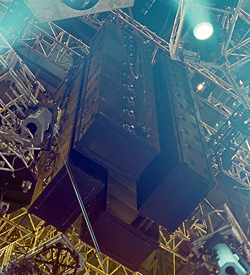The TM Array is actually nothing but a line array in the vertical, and a point source in the horizontal. Line arrays in theory are based on omni-directional sources, placed relatively close together, so subwoofers are the perfect choice for building a line array just by their nature.
The vertical coverage is controlled by the (vertical) length of the array. Ten boxes, which is a length of about six meters, provide a good directivity down to frequencies of about 45 to 50 Hz. We had to tweak the EQ a little around 30 to 35 Hz to get the stage really clear.
Alternatively we could have used more boxes in the array, but more boxes meant more weight, which was a big issue, and also the trim height for the array was limited in most cases. In the end, 10 were a good compromise.
In the horizontal, the goal was to create something that had a perfect 360-degree coverage with no hot, or dead, spots. In this regard, there were two points to be considered.
First, we had to keep the horizontal dimension of the array smaller than the reproduced wavelength in order to keep it omni-directional.
Second, we had to keep the individual sources closer together than one third of the shortest wavelength, in order to avoid creating destructive interference between the sources.
This also makes the array extremely efficient, because we don’t lose energy due to cancellation between the sources. With cardioid subwoofer arrays distributed around the stage, we would have needed more than twice as many subwoofers to get the same output.
The TM Array is really about using what we already know about loudspeakers, a principle we teach in the Meyer Sound education seminars. MAPP Online Pro was essential to the fruition of this project – the software allowed me to experiment, and create the system with total confidence that it would work. We’re living in a world of physics, and physics is predictable.
To create that huge, signature Metallica sound, they need 138-140 dB – it requires a lot of energy to fill those 20,000-seat venues. The array was designed as a solution for this problem, especially because live sound in-the-round is always a challenge.
We tried out the new design for two pre-release shows in Berlin and London, and because of the incredible results and positive audience feedback, we were able to go ahead with the design for the world tour.
The hardest part about the project was establishing such an innovative array in a tour of this scale, since it has never been done before. If it hadn’t been for Meyer Sound’s relationship with Big Mick Hughes, Paul Owen and Thunder Audio, and Metallica, it probably would never have happened.
This was the first time, in my experience, that the needs of sound won over lighting. It was a four- or five-week struggle with lighting to get the subwoofer array placed where we wanted it. As a sound designer, you’re typically the last person in the chain asked for his opinion, after lighting and video have already had their say.
But this time, the thinking was: We’re talking about the best band in the world, the best production in the world, the best front of house engineer in the world – let’s do the best sound design in the world.
Thomas Mundorf is part of Meyer Sound’s European Technical Support team.















